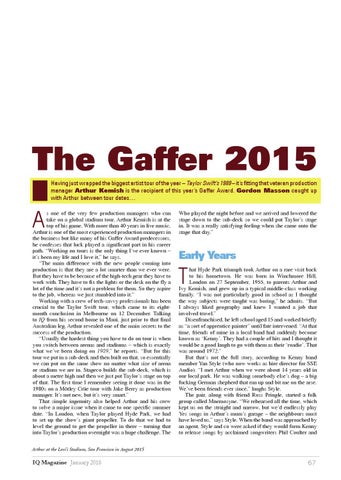The Gaffer 2015 Having just wrapped the biggest artist tour of the year – Taylor Swift’s 1989 – it’s fitting that veteran production manager Arthur Kemish is the recipient of this year’s Gaffer Award. Gordon Masson caught up with Arthur between tour dates…
A
s one of the very few production managers who can take on a global stadium tour, Arthur Kemish is at the top of his game. With more than 40 years in live music, Arthur is one of the most experienced production managers in the business but like many of his Gaffer Award predecessors, he confesses that luck played a significant part in his career path. “Working on tours is the only thing I’ve ever known – it’s been my life and I love it,” he says. “The main difference with the new people coming into production is that they are a lot smarter than we ever were. But they have to be because of the high-tech gear they have to work with. They have to fix the lights or the desk on the fly a lot of the time and it’s not a problem for them. So they aspire to the job, whereas we just stumbled into it.” Working with a crew of tech-savvy professionals has been crucial to the Taylor Swift tour, which came to its eightmonth conclusion in Melbourne on 12 December. Talking to IQ from his second home in Maui, just prior to that final Australian leg, Arthur revealed one of the main secrets to the success of the production. “Usually the hardest thing you have to do on tour is when you switch between arenas and stadiums – which is exactly what we’ve been doing on 1989,” he reports. “But for this tour we put in a sub-deck and then built on that, so essentially we can put on the same show no matter what size of arena or stadium we are in. Stageco builds the sub-deck, which is about a metre high and then we just put Taylor’s stage on top of that. The first time I remember seeing it done was in the 1980s on a Mötley Crüe tour with Jake Berry as production manager. It’s not new, but it’s very smart.” That simple ingenuity also helped Arthur and his crew to solve a major issue when it came to one specific summer date. “In London, when Taylor played Hyde Park, we had to set up the show’s giant propeller. To do that we had to level the ground to get the propeller in there – turning that into Taylor’s production overnight was a huge challenge. The
Who played the night before and we arrived and lowered the stage down to the sub-deck so we could put Taylor’s stage in. It was a really satisfying feeling when she came onto the stage that day.”
Early Years
T
hat Hyde Park triumph took Arthur on a rare visit back to his hometown. He was born in Winchmore Hill, London on 27 September, 1955, to parents Arthur and Ivy Kemish, and grew up in a typical middle-class working family. “I was not particularly good in school as I thought the way subjects were taught was boring,” he admits. “But I always liked geography and knew I wanted a job that involved travel.” Disenfranchised, he left school aged 15 and worked briefly as “a sort of apprentice painter” until fate intervened. “At that time, friends of mine in a local band had suddenly become known as ‘Kenny’. They had a couple of hits and I thought it would be a good laugh to go with them as their ‘roadie’. That was around 1972.” But that’s not the full story, according to Kenny band member Yan Style (who now works as hire director for SSE Audio). “I met Arthur when we were about 14 years old in our local park. He was walking somebody else’s dog – a big fucking German shepherd that ran up and bit me on the arse. We’ve been friends ever since,” laughs Style. The pair, along with friend Ross Pringle, started a folk group called Mnemosyne. “We rehearsed all the time, which kept us on the straight and narrow, but we’d endlessly play Yes songs in Arthur’s mum’s garage – the neighbours must have loved us,” says Style. When the band was approached by an agent, Style and co were asked if they would form Kenny to release songs by acclaimed songwriters Phil Coulter and
Arthur at the Levi’s Stadium, San Francisco in August 2015
IQ Magazine January 2016
67
